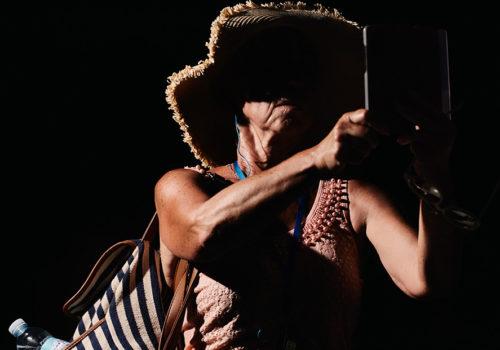Louis De Belle’s latest monograph, Crowd, confirms what has been emerging from his previous work: he is a nosy parker –a quaint British expression for someone who likes to pry into and find out about matters that do not concern them. Other terms like rubberneck or voyeur do not hit the spot where this expression properly belongs – they are too judgemental – and cannot apply to De Bell’s interest in photographing The World Fair for Church Supplies, Liturgical and Ecclesiastical Art, boat engines in the canals of Venice or the gimmicks used by magicians.
‘Since my first book I’ve always tried to create a strong connection between the content of the book and the way it was produced, through paper, printing and binding techniques. Failed Dioramas was about stuffed animals lying between boxes in an abandoned apartment so the book was printed on cardboard paper. Besides Faith was about Italy’s biggest religious trade fair, so we printed the book on golden paper. Disappearing Objects was about magic tricks, so we hid the photographs between the pages of a fiction story.’ De Belle’s statement in an interview compels one to ask what the form and presentation of Crowd says about selfie-takers, the main subject matter of his new photobook.
The inside of the front cover has two sentences about the millions of visitors who come to places like Rome, Milan and Venice and on the inside of the back cover an art historian equates their use of mobile phones with the notebook and fountain pen in the pockets of gentlemen who undertook the Grand Tour in centuries past. The homology only goes a little way given that most of the photographs in this book are of tourists taking photos of themselves, some of them holding their smartphones in both hands up above their faces in acts of self-homage or passively gazing into the lens as one might do in front of a mirror.
Reflexivity is at work in Crowd in a way that goes beyond the obvious meta- dimension of a photographer taking shots of people photographing themselves. De Belle uses a fast exposure time and a portable flash to catch moments of self-performance and the theatricality is registered by surrounding them in a blackness that suggests the sole intent of a solitary individual to record their own nonfungible presence. There are peripherals in the pictures – handbags, backpacks, earbuds, an occasional umbrella, ice cream or water bottle– but nothing is seen to distract from a very private moment of immersion in the self.
Perhaps it is not immersion but a search for identity. For the psychoanalyst Jacques Lacan, the subject’s search for an illusionary wholeness is potentially traumatic because there is always something missing, an incompleteness robbing it of any self-transparent consistency. The selfie delivers the deep wish for a warranted immediacy of being – and it is only an arm’s length away – a selfish act which, requiring no background, is not provided with one by De Belle. He is a nosy parker because it is purely their own business and other people have no place in it.
Sean Sheehan
















